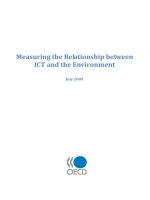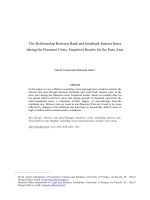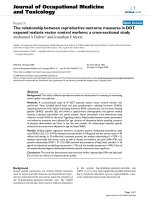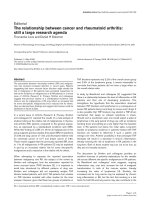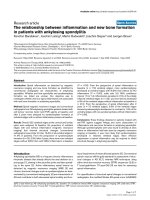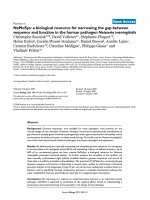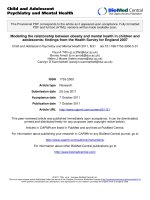The relationship between investment and dividend in cash flow uncertainty condition a vietnam case
Bạn đang xem bản rút gọn của tài liệu. Xem và tải ngay bản đầy đủ của tài liệu tại đây (1.34 MB, 62 trang )
UNIVERSITY OF ECONOMICS
INSTITUTE OF SOCIAL
HO CHI MINH CITY
STUDIES
VIETNAM
THE HAGUE
NETHERLANDS
VIETNAM – NETHERLANDS
PROGRAMME FOR M.A IN DEVELOPMENT ECONOMICS
THE RELATIONSHIP BETWEEN
INVESTMENT AND DIVIDEND IN CASH
FLOW UNCERTAINTY CONDITION: A
VIETNAM CASE
By
TRAN THI NHAT LINH
MASTER OF ARTS IN DEVELOPMENT ECONOMICS
Ho Chi Minh City, April 2017
ABSTRACT
This paper aims to show the relationship between investment and dividend in cash flow
uncertainty condition by using data of 246 Vietnamese listed firms from 2011 to 2014. The study
shows that in the relationship between investment and dividend does not significant in both two
alternative measurement methods of cash flow uncertainty. However, in the case cash flow
uncertainty is measured by cash flow shortfall, the relationship between investment and dividend
in each level of shortage is significant at 10%. Besides, the study shows that Vietnamese firms
tend to reduce liquid assets to deal with cash flow shortage and Vietnamese firms tend to invest
in other firms despite of they are facing with cash flow shortfall.
Keywords: dividend, investment, cash flow shortfall, Vietnamese firms
i
ACKNOWLEDGEMENT
Firstly, I would like to sincerely thank Dr. Vu Viet Quang. I am grateful to his
enthusiastic instruction crucial advice and valuable guidance during the time I worked with this
thesis.
In addition, I would like to thank you to all professors and staff of Vietnam-Netherlands
Program as well as classmate for their help during my thesis process.
Finally, I would like to express my gratitude to my family, who have supported me with
the master program and motivated me to finish this thesis.
ii
ABBREVIATIONS
HoSE: Ho Chi Minh Stock Exchange
OLS: Ordinary least squares
GLS: Generalized least squares
FE: Fixed Effect
RE: Random Effect
WLS: weighted least squares
iii
TABLE OF CONTENTS
CHAPTER 1 : INTRODUCTION..........................................................................1
1.1. Problem Statement................................................................................................................. 1
1.2. Research Objectives ............................................................................................................... 2
1.3. Data and Methodology .......................................................................................................... 3
1.4. Thesis Structure ..................................................................................................................... 3
CHAPTER 2 : LITERATURE REVIEW .............................................................5
2.1. Literature review ................................................................................................................... 5
2.1.1. The tradeoff theory between dividend and investment ..................................................... 6
2.1.2. Agency cost theory of free cash flow ................................................................................ 6
2.2. Empirical research related to the link between investment and dividend ....................... 7
2.2.1. Separated results ................................................................................................................ 7
2.2.2. Dependence results ............................................................................................................ 7
2.2.3. Others finding.................................................................................................................... 9
2.4.
Summary ........................................................................................................................... 12
CHAPTER 3 : DATA AND METHODOLOGY ................................................13
3.1. An overview of dividend, investment in Vietnam ............................................................. 13
3.1.1. An overview of dividend ................................................................................................. 13
3.1.2. An overview of investment ............................................................................................. 14
3.2. Analytical framework .......................................................................................................... 15
3.3. Sample data and collection .................................................................................................. 17
3.4. Methodology model .............................................................................................................. 17
3.4.1. Empirical model .............................................................................................................. 17
3.4.2. Variable measurements ................................................................................................... 18
3.5. Econometrics framework .................................................................................................... 21
3.5.1. Ordinary Least Square estimation ................................................................................... 21
3.5.2. Fixed effect estimation .................................................................................................... 21
iv
3.5.3. Random Effect estimation ............................................................................................... 22
3.5.4. OLS, FE, and RE, which one is better? ........................................................................... 22
3.5.5. Other tests ........................................................................................................................ 23
CHAPTER 4 : EMPIRICAL RESULTS AND DISCUSSION..........................25
4.1. How can firms solve cash flow shortfall ............................................................................. 25
4.2. Empirical results and discussion ........................................................................................ 35
4.2.1. Cash flow uncertainty is measured by CFVol ................................................................. 35
4.2.2. Cash flow uncertainty is measured by cash-short ........................................................... 39
4.2.3. Regression results ............................................................................................................ 40
4.3. Results summary .................................................................................................................. 42
CHAPTER 5 : CONCLUSION ............................................................................43
5.1. Main conclusion ................................................................................................................... 43
5.2. Implication ............................................................................................................................ 43
5.3. Limitation ............................................................................................................................. 44
REFERENCES .......................................................................................................45
APPENDICS ...........................................................................................................48
v
LIST OF TABLES
Table 3.1: Variables definition ..................................................................................................... 20
Table 4.1: Description statistics of the main variables (in billions VND or times) ...................... 26
Table 4.2: The main methods to deal with cash flow uncertainty (based on cash flow shortfall - in
billions VND)................................................................................................................................ 27
Table 4.3: The main methods to deal with cash flow uncertainty (based on cash flow shortfall) –
with negative sample and positive sample - in billions VND ....................................................... 31
Table 4.4: The main methods to deal with cash flow uncertainty (based on cash flow volatility) –
with negative sample and positive sample - in billions VND ....................................................... 33
Table 4.5: The correlation maxtric and variance inflating factor (VIF) (CFVol) ......................... 38
Table 4.6: The results of Modified Wald test and Wooldridge test .............................................. 39
Table 4.9: Regression results ........................................................................................................ 41
vi
LIST OF FIGURES
Figure 3.1: Number of listed firms payout dividend..................................................................... 14
Figure 3.2: Number of Vietnamese listed firms use internal fund (retain earnings) .................... 15
Figure 3.3: Conceptual Framework .............................................................................................. 15
Figure 4.1: Investment – dividends sensitive with CFVol rank.................................................... 36
Figure 4.2: Investment – dividends sensitive with cash short rank .............................................. 39
vii
CHAPTER 1 : INTRODUCTION
1.1. Problem Statement
Investment and dividend policy decisions are two of the most important missions fulfilled
by managements. In a perfect market, investment and dividend decision are a separation because
firms can raise external fund (Miller & Modigliani, 1961). In an imperfect market, firms cannot
obtain funds easily because of the limit resource, thus, investment and payout policy are the most
difficult decisions of manager and firms. Additionally, maximizing firm value and stockholder
wealthy are the main duties of administrators; however, sometimes there is confliction between
these duties, especially in cash flow uncertainty conditions. To be specific, firms usually use
profit after tax to pay out a dividend and reinvest in projects to create value in the future, but in
cash flow shortfall case, the manager will take into account for cutting the dividend and
investment, or raising external funds. In fact, firms can choose no payout a dividend when the
director boards believe that firms will have more advantages to increase profit as well as a
dividend in the next business cycle by expanding investment activities associated with
shareholders’ dividend. Nevertheless, these decisions are not always right; Benjamin and Dodd
(1934) gave some reasons to protest ones. Moreover, dividend payout is not only reflected
shareholder wealth, but also a signal for firms’ performance (Fairchild, 2010). Therefore, there is
the tradeoff between dividend and investment decision and managers have to choose the relevant
plans in order to increase shareholders’ wealth and firm value. As the results, dividends and
investment decision do not separate and must be jointly determined.
In particular, investment and dividend decision are affected by many factors, such as
agency cost, financial market. Therefore, therearemany studies related to investment and
dividend decision over the world but given different results. Some studies claimed that dividend
is priority decision (Lintner, 1956), but another one supposed that investment and dividend
decision are made simultaneously and interdependently (Brav et al., 2005). To clarify the
relationship between investment and dividend, some authors research this relation in a finance
constrained (Holt, 2003), financial flexibility (Daniel et al., 2008) or uncertainty cash flow
conditions (Deng et al., 2013). Overall, firms have to choose between investment and dividend
decisions in conditions of cash flow shortfall. Firms with cash flow shortfall are often difficult to
1
raise external funds and the cost of capital is higher. Therefore, this relationship is expressed
more clearly in firms with uncertainty cash flow.
In Vietnam, it is difficult to clarify the relationship between financial decisions,
especially the relationship between investment decisions and dividend decision. As reviewed by
Lý, H., & Thị, T. (2013), Vietnamese firms’ administrators agree on the importance of dividend
policy, but they are not clear how investment policy will affect dividend policy and vice versa.
Almost previous studies related to developed countries but the effect of the financial decisions in
each region is different with others; therefore, it is necessary to investigate the association
between dividend and investment decision in an emerging financial market like Vietnam.
In this study, the linkage between investment and dividend is the main research objective.
The results show the investment – dividend-sensitive as well as the change of investment and
dividend when cash flow volatility. Besides, empirical results also show the way Vietnamese
firm resolve cash flow shortfall. There are a lot of previous studies that research the connection
between investment and dividend with different results. In particular, some studies show the
independent relationship between dividend and investment (Morgan & Saint-Pierre, 1978), some
papers illustrate the interdependence between them (Minton & Schrand, 1999; Daniel et al.,
2008). However, Vietnam financial market still immature and incomplete, as well as there are
few studies that link financial decisions in Vietnam, so that the results of this study maybe bring
some suggestions for administrators.
1.2. Research Objectives
In general, this paper focuses on the link between investment and dividend of Vietnamese
firms in uncertainty cash flow. In addition, the study aims to find out the methods that
Vietnamese firms use to deal with cash flow shortage.
Firstly, this paper will determine variables that related to investment, dividend and cash
flow based on the method of empirical study, especially, cash flow uncertainty is measured by 2
methods: cash flow shortfall and cash flow volatility. Secondly, based on the magnitude of cash
flow shortfall, data is divided into 5 groups and variables are analyzed in each group or
combined to others. Statistic results will provide the evidence of the main channel to solve the
shortage of cash flow of Vietnamese firms.
Secondly, investment, dividend, and cash flow will be placed in relation to other factors
to run the regression in each level of cash flow shortfall. The coefficient of the dividend is
2
investment – dividend-sensitive. Based on the investment – dividend-sensitive in each level of
shortfall, we predict the relation of investment, dividend, and cash flow uncertainty then plots the
chart.
Thirdly, based on the chart, dummy variables are used and included in the model then the
results from regression will clarify the relationship between investment and dividend in each
level of shortfall.
The objective of this study is to identify the relationship between dividends and
investments in conditions of cash flow uncertainty for Vietnam listed firms. To examine this
problem, the thesis will answer the question:
Do investment decision and dividend decision independent when firms face with cash
flow volatility?
1.3. Data and Methodology
This study will use the panel data of non-financial companies, which are listed on Ho Chi
Minh Stock Exchange (HoSE) from 2011 to 2014. Besides, the study excludes the firms which
are listed after 2011 and the firms were not listed in the stock market before November 2015.
The final sample includes 984 firm-year observations. The data from the financial statement,
data will be used to conduct.
The descriptive statistics will be used to clarify the relation between dividends and
investment at the different level of cash flow uncertainty and find out solutions to resolve cash
flow uncertainty. The basic regression such as GLS, FE, RE also used to analyze the dividends investment sensitive to investigate the link between investment and dividend. Besides, this paper
uses piecewise regression to confirm the results that were predicted in the descriptive statistics
part and check the robustness of regression results.
1.4. Thesis Structure
This paper is organized including 5 chapters. Chapter 2 represents some definition,
related literature and empirical. Chapter 3 will describe the data and methodology. Chapter 4
shows empirical results. Finally, Chapter 5 is a conclusion and some limitation.
In detail, chap two will illustrate some concepts of dividend, investment, and cash flow.
After that, the relationship between investment and dividends in empirical research is divided
3
into various groups depend on different results. Finally, based on the summary of results from
empirical studies, hypotheses of the study will be given.
4
CHAPTER 2 : LITERATURE REVIEW
In next chapter, firstly, an analytical framework is presented. After that, data and
variables measurement are presented, the information of data source is given. Thirdly, a research
model is launched.
This chapter will illustrate some concepts of dividend, investment, and cash flow. In next
part, the literature of the relationship between investment and dividends is reviewed. In this
section, the empirical studies are mentioned to clarify the relationship between investment and
dividends in different conditions. Finally, a hypothesis is launched.
2.1. Literature review
“If you cannot find investments that make your minimum acceptable rate, return the cash
to owners of your business” (Damodaran, 2004). In fact, the dividend is an after – tax profit
which pays for shareholders. In discussing the dividend decision, Damodaran (2004) view the
dividend decision as an action to refund money for investors when firms do not find profitable
investment projects. Dividend decision is one of the most important of firms, iteffects to
available and the cost of capital. In particular, dividend policy is decided by Board of Directors
but it must be considered the desire of shareholders. Besides that investment decision took into
account when firms make dividend decision. Therefore, there is confliction between
shareholders’ benefit and managers.
According to Damodaran (2004), the investment decision means investing in assets that
“earn a return greater than the minimum acceptable hurdle rate”, and "any decision that requires
the use of resources is an investment decision”. Indeed, the primary goal of investment decision
to reallocates financial resource in order to bring the highest return for firms. The source of
investment includes internal financial (retained earnings) and external financial (loans and
bonds).
Based on Richardson (2006), “free cash flow is cash flow beyond what is necessary to
maintain assets in place (including servicing existing debt) and to finance expected new
investment”.
5
Jensen (1986) supposed that “free cash flow is cash flow in excess of that required to
fund all projects that have positive net present values when discounted at the relevant cost of
capital”.
Therefore, the available free cash flow has the important role of firm operations; its major
is used to pay dividends, and reinvestment. In addition, cash flow uncertainty caused more
problems for firms in both positive cash flow and negative cash flow. In particular, high free
cash flow lead to higher agency cost and increasing conflicts of interest between shareholders
and managers, but firms with negative cash flow have to raise funds to invest in the profitable
project. Furthermore, it is difficult to attract external funding or payout dividends to shareholders
when firms have negative free cash flow.
2.1.1. The tradeoff theory between dividend and investment
Miller and Modigliani (1961) investigated dividend policy, growth, and valuation of
share in the perfect capital market. The study assumes that firms will pay a dividend when firms
have positive cash flows. The authors claimed that if firms want a higher dividend payment in
any time period, the more cash must be raised from external to keep the desired investment level.
Thus, changes in investment decisions affect dividend decisions, but not vice versa. Besides,
cash flow uncertainty only affects dividends rather than investment because firms can raise fund
for positive projects in the perfect financial market.
2.1.2. Agency cost theory of free cash flow
Jensen and Mecking (1976) defined the concept of agency cost and showed the conflict
between managers and shareholder. The study claimed that dividend payment reduces managers’
power so firms must depend on financial markets to obtain new capital. In order to increase
controlling, managers will reduce available free cash flow of firms, it mean, managers will even
invest in the low-return project instead payout dividend.
Another study of Jensen (1986) related to agency cost claimed that managers could
allocate free cash flow by increasing dividend, purchasing a share, investing in low return
projects or waste. In order to decrease agency cost, firms can choose to reduce cash flow
available for spending, so overinvest is a good alternative for firms. Besides, Jensen suggests that
managers should issue debt, over-investment or misallocate free cash flow and promise to payout
6
in future. Thereby, the manager can retain free cash flow for future and increase the discretion of
managers.
2.2. Empirical research related to the link between investment and dividend
2.2.1. Separated results
Miller and Modigliani (1961) based on basic assumption then find out the relationship
between investment and dividend. The results support that the dividend and investment are
separable in a perfect market. The link between investment and dividend become controversial
topics and attracted the attention of economists.
Contract to Dhrymes and Kurz (1967), the findings of Higgins (1972) indicate that
investment, dividend and external funds are separated but are made simultaneously. Higgins
(1972) used the cross section data of firms operating in eight industries in the year 1961, 1963,
1965 to examine dividend – saving the model and the factors that maximize firm value. The
findings show that no evidence which proves the interdependence between investment and
dividend.
Following the research findings of Miller and Modigliani (1961), Fama (1974) is also
study the link between dividend and investment of firm but in an imperfect market. This research
based on the model of John Lintner and the data of 298 firms over a23-year period. The results
indicated that dividend and investment decisions are independent in the imperfect capital market.
In addition, dividends related to investment but it was not evaluated by investment.
Related to investment and dividend decision, Smirlock and Marshall (1983) use the data
of 194 firms in 20 year period to provide the evidence the relationship between them. The
purpose of the study is to provide evidence to support M-M theorem and test the independence of
investment and dividend by causality test. The findings consistent with the study of Fama (1974)
and prove that does not exist the interdependence between investment decision and dividend
decision.
2.2.2. Dependence results
In fact, the firm cannot make both investment and dividend decision simultaneously
because of limited capital in the imperfect market. So, many studies related to two important
financial decisions in market conditions are not perfect but given many contradictory decisions.
7
By using OLS, 2SLS, 3SLS, Dhrymes and Kurz (1967) used the data of 181 from 1951 to 1960
to investigate the relationship between dividends, investment, and new debt. The findings against
M-M theorem and proposed that the investment and dividend decisions are interdependent, and
investment decisions have a significant effect on firms’ dividend behavior.
M. McCabe (1979) brings a new look related to investment and financing. The study uses
cross-sectional data including 112 firms from 1966 to 1973 and based on three models of
Dhrymes and Kurz (1967).The findings of the study show a negative correlation between
investment and dividend. In addition, the result shows that investment and dividends decision
cannot be determined independently of the others financial variable and in a long term,
dividends, investment, and new debt will be set at an equilibrium level.
Based on the model of Dhrymes and Kurz (1967) and M. McCabe (1979), Peterson and
Benesh (1983) tested the link between investment and financing decisions. The findings
consistent withthe study of Dhrymes and Kurz (1967) and M. McCabe (1979) and indicated the
significant positive relationship between investment and dividends. The results also show a
positive correlation between investment and new debt as well as the evidence of study show that
investment decision is affected by financing decision and they are jointly determined.
By using both cross-sectional and time series data of 378 firms from 1960 to 1972, the
study of Baskin (1989) inconsistent with Fama (1974) and the findings show that past dividend
has a significant effect on investment.
Devereux and Schiantarelli (1990) use panel data of 720 UK firms and the Q model to
investigate the linkage between investment, cash flow and financial factors in the UK. The
results contrast with previous studies of MM and Fama (1974). In fact, the findings show that
cash flow have significant related with investment, and leverage has a negative effect on
investment. In particular, the impact of cash flow on investment is more significant in large
firms, and vice versa.
Similar to Bhaduri and Durai (2006), Wang (2010) used causality to investigate the
relationship between investments, dividend, and financing in the high-tech industry. The study
uses data from 178 firms in China and Taiwan during the period 2000 – 2007. Wang (2010)
indicated that investment and financing have a positively significant relationship but dividend
and financing have no significant relationship. In addition, the results do not show the direct
8
relationship between investment and dividend and do not consistent with Fama (1974), Smirlock
and Marshall (1983).
Deng et al. (2013) obtained data from 2000 to 2010 of nonfinancial firms in China and
investigated the relationship between investment decisions and payout policy in cash flow
volatility condition. The study explored that firms with cash flow uncertainty do not cut dividend
or investment but remained high investment level. Besides, Chinese firms used external cash as
the main instrument to resolve cash flow uncertainty.
2.2.3. Others finding
Based on the data of 116 Canadian firms in the period 1960 -1974 and the methods of
Fama (1974), Morgan and Saint-Pierre (1978) test the link between investment and dividends.
The study examines this relation in short term and long term. The results show a negative
relationship between investment and dividends in long run but the findings support the results of
Miller and Modigliani (1961).
Louton and Domian (1995) also researched on the relationship between dividends and
investment but indicated different results with previous studies. This study used a database of
212 firms in 37 years and Granger causality test to finding that dividends related to investment
decisions in approximately 33 percent of firms, irrespective sectors.
Based on M-M theorem, Mc Donald et al. (1975) also examined the correlation between
investment and dividends of French firms. Mc Donald et al. (1975) used dividend model,
investment model and financing model to clarify the link between investment, dividend and
financing decision of French firms. The results from dividend model show that investment and
external financing are insignificant with dividends. In investment model, the results show the
positive significant relationship between investment and dividends; this finding is inconsistent
with MM theory. In conclusion, the evidence from French firm of Mc Donald et al. (1975)
cannot reject MM theory but they also do not support the study of Dhrymes and Kurz (1967).
Brav et al.(2003) surveyed 384 financial managers by field interview combined with
tradition survey methods to find out the factors that drive payout policy. The research indicated
that priority of firm is maintaining dividend level, and dividend payment is next concern after
considering investment and liquidity needs. Besides, the manager will consider raising external
cash or delaying investment to maintain dividend level. Another result show that remains
9
dividend per share more important than increase investment, however, investment decisions is
considered priority than increasing dividends level. The research also discusses the impact of
free cash flow to payout policy.
Differ previous studies, DeAngelo and DeAngelo (2006), Bhaduri and Durai (2006)
researched the link between dividend and investment decisions. While DeAngelo and DeAngelo
(2006) point out the irrelevant assumptions of M – M then Bhaduri and Durai (2006) study based
on data from 265 Indian manufacturing firms in the period 1992 – 2004 and panel Granger
causality test to clarify the M-M separation principle in India. The results from research reject
the M-M separation principle and show that dividend and investment have bidirectional causality
relationship for low growth firms and unidirectional causality relationship for high growth firms.
The result from the study of Daniel et al. (2008) defined the link between investment and
dividend. The study indicated the change of dividend and investment level when firms faced to
cash flow shortfall. Authors supposed that firm needs to do one of the options as reduced
investment, cut the dividend, raised funds or reduced cash reserves. The results of the study show
that approximately 6% of firms cut dividend while 68% firm cut investment to solve cash flow
shortfall problem. Investment cuts resolve approximately 50% shortfalls, the rest were resolved
by debt, equity financing, drawdown cash balance have a minor contribution.
Recently, some studies found the link the link between investment and dividend such as
DeFusco et al. (2014). The study uses VAR Causality method and data of 1056 firms from 1950
to 2006 to clarify the relation of investment, dividends, and earnings. The results provide strong
evidence the interdependence between investment and dividend decisions and the shocks to
dividends impact to investment in long-term and vice versa. In addition, the results show a
negative relationship between investment and dividend and firms with more profitable projects
will have the sharp fluctuations in dividend when investments receive the shock.
2.3. Empirical research related to cash flow, investment, dividend and other factors
When discussing the relation between firm size, cash flow, and investment, Kadapakkam
et al. (1998) investigated the data from OECD countries then gave some conclusions. Firstly, the
internal fund has an effect on firms; the significant depend on the size of the firm. Secondly, cash
flow has a positive effect on investment and cash flow – investment sensitive is highest in large
firms and lowest in small firms. Related to cash flow shortfall, Bradley et al. (1998) study the
10
role of cash flow to dividend policy by using the sample from 1985 to 1992 in REIT industry.
The results show the negative relationship between dividend and cash flow volatility as well as
the authors proved that payout level will lower if expected cash flow volatility is higher. In
addition, Bradley et al. (1998) claimed that managers will set dividend policy lower if expected
cash flow less certain. Another important finding of the study is the link between investment and
financing decisions.
The relationship between cash flow and investment is clarified by Minton and Schrand
(1999). The study of Minton and Schrand (1999) showed that cash flow volatility has a negative
effect on investment and higher cash flow volatility related to lower average levels of
investment; authors suggest firms should skip some investment to operate more smoothly instead
retain investment levels in cash flow uncertainty condition. The results of the study also point out
the negative relationship between dividend payout and net cash flow volatility.
Allayannis et al. (2005) investigated the relationship between earning uncertainty, cash
flow uncertainty, and firm value. The empirical results show that cash flow volatility has
negatively related to firm value. Besides, it increases firm’s cost to raise external cash for firms
then cash flow volatility effect to investment policy.
By using 58,053 firm-year observations from 1988 to 2002, Richardson (2006) found out
the relationship between free cash flow and investment. The study pointed out that firm with a
high level of free cash flow usually has overinvestment. In addition, almost free cash flow is kept
as a financial asset, some evidence proved the free cash flow is contributed from outside. The
study also indicated the positive relation between investment and cash flow.
The research of DeAngelo and DeAngelo (2007) investigated the financial flexibility,
dividend policy and capital structure of firms. Empirical results showed that firms can use debt
financing to create short-term funds in order to solve investment and earning shocks. Further,
firms should not be cash reserves absent because positive investment projects need funding with
a lag.
Empirical results of Chaya and Suh (2009) proved that cash flow volatility plays
important role in payout policy and its effects to payout method. In addition, the authors
indicated that firms will choose to purchase share instead pay dividends when it has high cash
11
flow uncertainty level. The study also pointed out that firms have more difficult and costlier to
raise external fund if they faced cashing flow uncertainty.
In addition, Daniel et al. (2010) found that firm will raise external funds to cover cash
flow shortfall. However, some evidence showed that cash holdings were the source to resolve
cash shortfall. In fact, almost firms chose to issue new debt in this situation, minor firms cut cash
reserve to reduce the shortfall, asset sales, decrease investment, dividend or equity financing.
The study also supported the results of DeAngelo and DeAngelo (2007) that leverage is a
cushion for cash flow shocks.
Bhagat and Obreja(2013) explored the impact of cash flow uncertainty on employment
and investment. The results indicated the negative relationship between cash flow volatility and
corporate investment in the asset. In addition, the negative relationship between cash flow
uncertainty and investment is stronger in post - recession.
2.4. Summary
In general, empirical research shows different results in various regions and market
condition but almost research based on the idea of Miller and Modigliani (1961) and the findings
of Dhrymes and Kurz (1967) and Fama (1974). Although there are differences in the methods,
data and the period of time, the results of researches focus in two main groups: independent and
separated. If Miller and Modigliani (1961) confirm investment dividends and independent in
perfect markets, Higgins (1972) and Smirlock and Marshall (1983) conclude them independently
both in imperfect markets. However, the findings of subsequent studies against M-M theorem
and point out the link between investment and dividend decision in various conditions. The
typical study that does not support M-M theorem is the study of Dhrymes and Kurz (1967). After
that, M. McCabe (1979), Peterson &Benesh (1983) based on the model and method of Dhrymes
and Kurz (1967) to provide evidence against M-M theorem. Recently, the studies such as Bhagat
and Obreja(2013), DeFusco et al. (2014) in different regions, a period of time and method also
support the separation. In fact, dividends and investment cannot be done simultaneously because
of limit capital in the imperfect market. Therefore, this paper supports the idea that exists the
relationship between investment and dividend.
Hypothesis: there is a positive relationship between investment and divide
12
CHAPTER 3 : DATA AND METHODOLOGY
The main content of this section is to present the sources of data, how the sample data is
collected, variable measurement, and the relationship between dividend and investment in the
context of Vietnam. Firstly, this chapter will introduce an overview of dividend and investment
of listed companies in HoSE. Next, conceptual framework and model specification will be
discussed in detail in order show the relationship between investment and dividend. Thirdly,
research hypotheses and variables measurements are included to clarify the purpose of this study
in next part. Finally, data collecting and data filtering method will be mentioned in the last
section.
3.1. An overview of dividend, investment in Vietnam
3.1.1. An overview of dividend
The dividend payment is defined that the amount of after-tax profit which is distributed to
shareholders after firms kept a portion for reinvestment in their operation. In fact, if firms do not
have enough good projects which have profitable higher than the cost of capital then firms
should payout surplus profit to shareholders. In Vietnam, firms have two times per year to
payout dividend and Board of Director will be face with dividend payout rate as well as the level
of retained profit for their operation. There are different in dividend payout rate among various
industries in Vietnam (Thu et al., 2013) but almost investors always see dividend payment as a
signal to invest. According to survey results, to some extent, the managers agreed with the
important of dividend policy but the managers are not an aware prioritization of investment
decisions and dividend policy (Lý, H., & Thị, T., 2013). In fact, under pressure from investors,
many firms use the leverage to expand its operations and pay dividends (Thu, N. K. et al., 2013).
Dividend policy of Vietnamese firms in 2011 and 2012 was discussed in research of Tran
Thu, P. (2013). According to Tran Thu, P. (2013), more than 18% firms listed on HoSE did not
have transparent information about their dividend payment in 2011. In next year, this proportions
rose to nearly double (30%). Besides that, those firms have various payment rates, which ranging
from 0% to 70% on their capital. In particular, approximately 60% firms have dividend payment
rate from 0% to 20%, 10% firms paid from 21% to 30% and a minor proportion firms have
dividend rate over 30%. Another research on Vietnamese firms points out that dividend policy is
13
a tool for controlling share price as well as investor see dividends as an important factor in
making investment decisions. In conclusion, dividend policy is an important decision that
Executive Board must be faced in corporate management and they must choose the level of
dividends payment and the magnitude of retained earnings to reinvestment.
In addition, from 2011 to 2013, the number of firms which did not pay dividend increase
nearly double but later on it dropped down slightly in 2014. In particular, 100 out of 264 listed
firms on HoSE did not pay a dividend in 2013. This ratio slightly decreases to 93 firms in 2014
but still account up to nearly 61% listed firms which are chosen from HoSE.
300
Number of firms
250
200
150
Non-dividend Payment
100
Dividend Payment
50
0
2011
2012
2013
2014
Year
Figure 3.1: Number of listed firms payout dividend
Actually, a good dividend policy should not be considered in isolation. It must be
combined with investment policy and financial policy based on long-term cash flow of firm.
3.1.2. An overview of investment
Investment decisions are one of the key financial decisions of the firm and affect to
firms’ profitability and growth. Board of directors makes investment decisions based on retained
earnings, and firms’ ability to have access to external funds support all of its new investment
opportunities. Vietnamese firms often have difficult to raise capital from banking, especially
small firm, so firms tend to use retained earnings to reinvestment. The research of Le, N. T. et al.
(2006) pointed out that almost firms rely on retained earnings, savings, or the fund of
14
shareholder instead of external financial. In fact, the data of 246 listed firms on HoSE shows that
almost firms retained profit for investment purposes. From 2011 to 2014, listed firms which do
not reinvestment their profit just accounted for 1% to 6%. It can be said that reinvested profit is a
priority task to generate their profits and growth.
The number of listed firms
300
250
200
150
Non-investment
100
Investment
50
0
2011
2012
2013
2014
Year
Figure 3.2: Number of Vietnamese listed firms use internal fund (retain earnings)
3.2. Analytical framework
Dividend
Investment
+ Cash flow uncertainty
+ Cash flow
+ Firm size
+ Market to Book ratio
+ Return of Asset
+ Leverage
+ Firm status
+ External financing
Figure 3.3: Conceptual Framework
15
This paper will clarify the relationship between investment and dividend in uncertainty
cash flow condition. In particular, dividend decision and investment decision are governed by the
conditions of cash flow uncertainty, financial performance, and financial decision. In this paper,
cash flow uncertainty is described by the level of shortage and they are alternatively measured by
two methods. In addition, financial performance includes operating cash flow, market to book
ratio, return on asset, firm size, leverage and financial decision which is represented by external
funds.
Based on literature finance, the relationship between investment and dividend may be
either independent (Miller& Modigliani, 1961, Morgan & Saint-Pierre, 1978), or interdependent
(Dhrymes & Kurz, 1967; Brav et al., 2005) from each other’s which and has a positive
relationship. In addition, in the Linter model, prior dividend may affect the expected dividend of
shareholders and board of directors and “dividends represent the primary and active decision
variable . . . savings in a given period are largely a by-product of dividend action." Thus, lagged
dividends are included in this study. Moreover, current profitability (ROA) is a key instruments
that determinant of current dividends (Lintner, 1956). These variables are similar with prior
literature that tests the relation between investments and dividends (Fama, 1974; Peterson and
Benesh, 1983).
Ramalingegowda et al., 2013 find the link between total investments and firm size,
leverage, cash flow from operations, cash flow volatility, investment volatility, cash balance and
market to book ratio. In addition, according to Smith and Watts (1992), firm size is associated
with dividend policy and debt. When studying about investment, prior models include in size and
leverage as variables that influent to investment (Richardson, 2006; Deng et al., 2013).
Therefore, firm size, leverage, cash flow, cash flow volatility, market to book ratio are included
in this study.
According to Brav et al., 2003; Deng et al., 2013, raising funds from outside is the first
order alternative when firms face with cash flow shortfall and the external fund is the solution to
resolve cash shortfall problem (Deng et al., 2013). Besides that, the study of Deng et al. (2013) is
also confirms the role of the firm status in the relationship between investment and dividend.
Therefore, firm status is included in the model.
16
3.3. Sample data and collection
The sample data is composed of 246 non-financial companies listed in HoSE from the
period 2011 to 2014. Moreover, non-financial firms, which are listed after 2011 and delisted
before November 2015, are excluded. The data is tested to remove outlier, so the final samples
include 984 firm-years observations. All data is obtained from financial statements from the
website of Vietstock1 and Viet Capital Security2.
3.4. Methodology model
3.4.1. Empirical model
Based on the study of Lintner (1956), Daniel et al. (2008), Deng et al. (2013),
Ramalingegowda et al. (2013) the relationship between investment and dividend in uncertainty
cash flow conditions will be estimated by model:
I_TA = α0 + α1 *DIV + α2*Rank + α3 *Dum1 + α4*Dum 2 + DIV *(α5*Rank+ α6 *Dum1 +
α7*Dum2) + Rank*(α8*Dum1 + α9*Dum2) + DIV*Rank
*
(α10*Dum1 + α11*
Dum2) + α12*Extcash + α13*CF + α14*Lag (I_TA) + α15*MB+ α16*Size + α17*ROA
+ α18*LEV + α19*State + ε
(1)
Where:
I_TA: investment divided by lagged total asset
Lag (I_TA): I_TA in previous year
DIV: dividend per share divided by lagged total asset per share
Dum 1 and Dum 2: dummy variables which taking value of 1 or 0 depend on the rank of
cash flow uncertainty
Rank: the level of cash flow uncertainty, there are 5 level and 2 ways to measure cash
flow uncertainty.
External cash: fund that is raised from equity financing and debt financing
CF is operating cash flow scaled by lagged total asset
MB: market to book ratio
Size: firm size which is estimated by natural logarithm of total asset
ROA: return of asset
1
2
/> />
17

